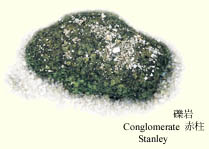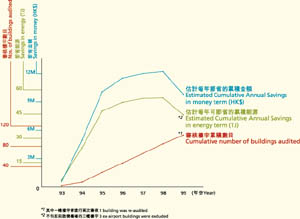Energy Efficiency
|
|
The increasing consumption of energy and the resultant depletion of fossil fuels as well
as the pollution caused in generating energy, has led to widespread acceptance around the
world of the need to conserve energy. At EMSD, with an Energy Efficiency Office to take a
proactive role and
lead the way, we are pioneers in energy efficiency management. |
 |
 |
An Energy Management Program has been in place since 1993 setting energy efficient
objectives and targets, time frames, determining methodologies, allocating both financial
and human resources as well as formulating and implementing action plans. Under this
programme, preliminary Energy Audits identified a number of energy management
opportunities in public and government buildings, which have achieved significant savings
in energy. |
The Energy Efficiency Office was established in 1994 to improve energy utilisation in
Hong Kong. The Office focuses its activities in two main areas. The first being the
conservation of energy through the setting up of guidelines for the efficient use of
energy, conducting energy audits, promoting an energy efficiency labelling scheme and the
compilation of an Energy End-use Database. The Office also conducts surveys and pilot
schemes to study technological options available for energy savings and cost viabilities.
Secondly it provides technical supervision in the monitoring of the performance of the
utility companies.
 Energy Audits
Energy Audits
Energy Audits form the first step in understanding where and how energy is used. They
provide the basis for energy management, identifying Energy Management Opportunities where
both energy and money can be saved.
| Energy audits go back to 1994 when we participated in the Government's
pioneering audit which was conducted to understand how well government departments were
doing with respect to environmental management. Learning from the exercise, we have since
conducted our own programme of energy audits both for our own premises and for our
customers, identifying Energy Management Opportunities and providing guidelines for
conserving energy. Up to the end of 1999, 103 audits have been completed and a further 52
are scheduled for completion, 27 in 2000 and 25 in 2001. |
 |
Our programme actively looked at the larger users of energy first, and programmes
implemented have subsequently saved our customers many millions of dollars. The programme
also includes repeat audits to measure the efficiency and effectiveness of previous
audits.
In March 1996, an Energy Management Opportunities Working Group was established to
develop a more centralised strategy for energy management and to make more proactive
energy management proposals to our customers. Building on the benefits of an Energy
End-use Database, the integrated information will provide the way forward, ensuring that
energy management projects are even more effective.

Energy Conservation Results 1993 -1999
ZOOM
Within EMSD we are also conducting a five-year pilot Energy Management Opportunity
Programme. Phase 1 ended in 1999 while the second phase will be completed by early 2001.
The first phase, which generated major savings, was based on energy efficient lighting
such as the use of electronic ballast and variable speed drives for air-conditioning. The
second phase is looking at more innovative technology such as dimmable electronic ballast,
for example, where the system can detect natural light and adjusts lighting level
accordingly. In the long term we are also looking at energy efficiency in the use of lifts
and escalators. An example is the "intelligent' lift system which will be able to
group people according to the floors they are going to, reducing the number of stops made
thus making significant savings in energy. A tender for this "intelligent" lift
at the Mongkok Government Offices was awarded at the end of 1999 and is scheduled to go on
trial in mid 2000. Surveys and audits will be conducted to assess the psychological impact
and energy efficiency of this intelligent lift system.
Energy Audits and Retrofit Projects in
Hospitals
| Promoting energy conservation, we have
been working very closely with the Hospital Authority (HA) to conduct a series of in-depth
energy audit surveys for their hospitals since 1998. Several energy management
opportunities with payback periods of less than 5 years were identified. Based on these
audits and the retrofit measures proposed, HA has subsequently confirmed funding amounting
to HK$50 million for lighting and other energy retrofit projects in twelve major
hospitals. The project work will commence in 2000 and is due for completion in mid 2002.
The anticipated energy saving after project completion is estimated to be around HK$12
million per annum with a payback period of 4 years. |
Energy Management Opportunities
(EMOs)
| Energy audits are conducted using
standard guidelines that we published in 1995. A simplified version has also been issued
for reference by building owners who are not trained as energy auditors. EMOs are identified through energy audits and fall into three
categories: Cat. 1 requires practically no capital outlay to implement, Cat. 2 can be
implemented at relatively low cost and Cat. 3 requires substantial capital investment and
is very complicated to implement.
Implementation not only requires identification of
EMOs but also suitable and innovative technology. The use of energy saving tubes and
electronic ballast for fluorescent lighting as well as variable speed drives for
air-conditioning are typical examples. The replacement of the T12 fluorescent tubes by the
slimmer and more energy efficient T8 tubes can save energy consumption by 10% while the
use of electronic ballast instead of the more conventional version can save an additional
20%-30%. Variable speed drives can reduce the flow of air when air-conditioning load is
low, saving upto 50% of the energy bill when there is a reduction of air flow of 20%. The
payback period therefore becomes a crucial element when determining the implementation of
EMOs. The payback period for the options mentioned above typically range from 3-8 years
though with both market competition and continuously advancing technology, there is a
continuing decline in the cost of equipment involved and thus the payback period. |
 Guidelines for the Efficient Use of Energy Guidelines for the Efficient Use of Energy
The Energy Efficiency Office also provides guidelines and Codes of Practice on the
efficient use of energy both within the community and business and industry.
 Energy Efficiency Labelling Scheme Energy Efficiency Labelling Scheme
| Initiated and managed by EMSD, this scheme was first introduced in June
1995. Aiming to save energy, energy labels on common household electrical appliances
inform potential customers of the product's level of energy consumption and efficiency
rating. Buyers can then take these factors into account when they make their purchasing
decision. Currently four schemes covering labels for 99 domestic refrigerators, 136
air-conditioners, 11 washing machines and 192 compact fluorescent lamps have been in
place. |
 |
In addition to domestic products, a similar scheme is being planned for
office equipment and will be implemented shortly. A preliminary feasibility study is also
under way to look at the possibility of using this labelling scheme for motor vehicles. |




